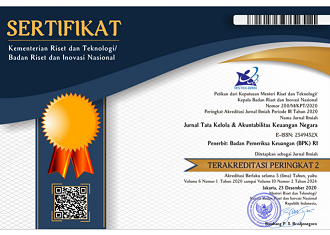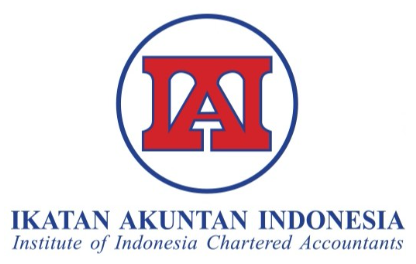Fraud Hexagon: Detection of Fraud of Financial Report in State-owned Enterprises in Indonesia
DOI:
https://doi.org/10.28986/jtaken.v9i1.1358Keywords:
Fraud Hexagon, Financial report, State-Owned EnterprisesAbstract
This study aims to identify the potential for fraudulent financial reporting using the Fraud Hexagon approach with pressure, capability, collusion, opportunity, rationalization, and ego indicators. The population in this study is state-owned companies with observations for 12 years, from 2010 to 2021, and uses regression analysis with SPSS tools to test the Hypothesis. The results showed that pressure and ego could detect the potential for fraudulent financial reporting. There is a tendency for management to report conditions that are different from the actual conditions when under pressure in the form of performance targets that are not supported by the resources they have. CEO duality also provides an excellent opportunity for fraudulent financial reporting practices because when there is a position war, there is no cross-check between departments, so other parts cannot detect the potential fraud committed by the CEO. This condition also indicates weak control processes that provide wider opportunities for fraudulent financial reporting. At the same time, variables of ability, collusion, opportunity, and rationalization cannot detect financial statement fraud. This condition is because state-owned companies are required to implement the Minister of Finance Regulation number PER-11/MBU/07/2021 and the Financial Services Authority number 13/POJK.03/2017 as the basis for the implementation of Good Corporate Governance so that it is possible to commit financial reporting fraud very small.
References
ACFE. (2020). Report to the nations on occupational fraud and abuse: 2020 global fraud study. Jakarta: ACFE.
ACFE Indonesia Chapter. (2019). Survei fraud Indonesia 2019. ACFE Indonesia Chapter, 76.
Achmad, T., Ghozali, I., & Pamungkas, I. D. (2022). Hexagon fraud: Detection of fraudulent financial reporting in state-owned enterprises Indonesia. Economies, 10(1), 1–16. DOI: 10.3390/economies10010013
Agusputri, H., & Sofie, S. (2019). Faktor - faktor yang berpengaruh terhadap fraudulent financial reporting dengan menggunakan analisis fraud pentagon. Jurnal Informasi, Perpajakan, Akuntansi, dan Keuangan Publik, 14(2), 105–124. DOI: 10.25105/jipak.v14i2.5049
AICPA. (2017). Consideration of Fraud in a Financial Statement Audit. Retrieved from https://onlinelibrary.wiley.com/doi/10.1002/9781119480310.ch12. DOI: 10.1002/97811194 80310.ch12
Albrecht, W. S., Albrecht, C. O., Albrecht, C. C., & Zimbelman, M. F. (2018). Fraud examination. Cengage Learning.
Apriliana, S., & Agustina, L. (2017). The analysis of fraudulent financial reporting determinant through fraud pentagon approach. Jurnal Dinamika Akuntansi, 9(2), 154–165. DOI: 10.15294/jda.v7i1.4036
Aviantara, R. (2021). The association between fraud hexagons and the government’s fraudulent financial report. Asia Pacific Fraud Journal, 6(1), 26. DOI: 10.21532/apfjournal.v6i1.192
Chantia, D., Guritno, Y., & Sari, R. (2021). Detection of fraudulent financial statements: Fraud hexagon S.C.C.O.R.E model approach. Business Management, Economic, and Accounting National Seminar, 2(3), 594–613.
Cressey, D. R. (1953). Other people’s money: A study of the social psychology of embezzlement. Illinois: Free Press.
Crowe, H. (2012). The mind behind the fraudsters crime: Key behavioral and environmental element. Crowe Horwath LLP, 1–62.
Daromes, F. E., & Jao, R. (2020). Peran mediasi kinerja keuangan pada hubungan dewan direksi dengan reaksi investor. Jurnal Akuntansi, 10(1), 77–92. DOI: 10.33369/j.akuntansi.10.1.77-92
Felli, L., & Vallve, R. H. (2015). Collusion, blackmail, and whistle-blowing. CESifo Working Paper Series No. 5343. DOI: 10.2139/ssrn.2607908
Fitri, F. A., Syukur, M., & Justisa, G. (2019). Do the fraud triangle components motivate fraud in Indonesia? Australasian Accounting, Business and Finance Journal, 13(4), 63–72. DOI: 10.14453/aabfj.v13i4.5
Ghozali, I., Achmad, T., & Pamungkas, I. D. (2019). Determinants of fraudulent financial reporting and whistleblowing system: Applying the theory of planned behavior. WSEAS Transactions on Business and Economics, 16, 393–402.
Habib, A., Muhammadi, A. H., & Jiang, H. (2017). Political connections, related party transactions, and auditor choice: Evidence from Indonesia. Journal of Contemporary Accounting and Economics, 13(1), 1–19. DOI: 10.1016/j.jcae.2017.01.004
Handayani, N., & Evana, E. (2022). Determination of fraudulent financial report: Case of the banking industry in Indonesia. Saudi Journal of Economics and Finance, 6(2), 51–56. DOI: 10.36348/sjef.2022.v06i02.002
Handoko, B. L., & Natasya. (2019). Fraud diamond model for fraudulent financial statement detection. International Journal of Recent Technology and Engineering, 8(3), 6865–6872. DOI: 10.35940/ijrte.C5838.098319
Ijudien, D. (2018). Pengaruh stabilitas keuangan, kondisi industri, dan tekanan eksternal terhadap kecurangan laporan keuangan. Jurnal Kajian Akuntansi, 2(1), 82–97. DOI: 10.33603/jka.v2i1.1247
Kamarudin, K. A., Ismail, W. A. W., & Samsuddin, M. E. (2012). The influence of CEO duality on the relationship between audit committee independence and earnings quality. Procedia - Social and Behavioral Sciences, 65, 919–924. DOI: 10.1016/j.sbspro.2012.11.220
Kang, M., Lee, H. Y., Lee, M. G., & Park, J. C. (2014). The association between related-party transactions and control-ownership wedge: Evidence from Korea. Pacific Basin Finance Journal, 29, 272-296. DOI: 10.1016/j.pacfin.2014.04.006
Larum, K., Zuhroh, D., & Subiyantoro, E. (2021). Fraudulent financial reporting: Menguji potensi kecurangan pelaporan keuangan dengan menggunakan teori fraud hexagon. AFRE (Accounting and Financial Review), 4(1), 82–94. DOI: 10.26905/afr.v4i1.5818
Lastanti, H. S., Murwaningsari, E., & Umar, H. (2022). The effect of hexagon fraud on fraud financial statements with governance and culture as moderating variables. Media Riset Akuntansi, Auditing & Informasi, 22(1), 143–156. DOI: 10.25105/mraai.v22i1.13533
Lou, Y. I., & Wang, M. L. (2009). Fraud risk factor of the fraud triangle assessing the likelihood of fraudulent financial reporting. Journal of Business & Economics Research (JBER), 7(2), 61–78. DOI: 10.19030/jber.v7i2.2262
Marks, J. T. (2009). Playing offense in a high-risk environment: A sophisticated Approach to fighting fraud. Retrieved from https://www.academia.edu/31698128/Playing_Offense_in_a_High_Risk_Environment_A_Sophisticated_Approach_to_Fighting_Fraud
Maryani, N., Natita, R. K., & Herawati, T. (2022). Fraud hexagon elements as a determination of fraudulent financial reporting in financial sector services. Budapest International Research and Critics Institute Journal, 5(1), 4300–4314. DOI: 10.33258/birci.v5i1.4136
Meidijati., & Amin, M. N. (2022). Detecting fraudulent financial reporting through hexagon fraud model: The moderating role of the income tax rate. International Journal of Social and Management Studies (IJOSMAS), 3(2), 311–322.
Nanda, S. T, Salmiah, N., & Mulyana, D. (2019). Fraudulent financial reporting: A Pentagon fraud analysis. Jurnal Ilmiah Ekonomi Dan Bisnis, 16(2), 122–134. DOI: 10.31849/jieb.v16i2.2678
Nugroho, D. S., & Diyanty, V. (2022). Fraud hexagon and fraudulent financial statement: Comparison between OMI and Beneish model. Proceedings of the International Conference on Economics, Management, and Accounting (ICEMAC 2021), 207(Icemac 2021), 1–10. DOI: 10.2991/aebmr.k.220204.001
Purnaningsih, N. K. C. (2022). Fraudulent financial reporting analysis on non-financial companies listed on IDX in Hexagon fraud perspective. Budapest International Research and Critics Institute (BIRCI-Journal), 5(2), 11331–11343. DOI: 10.33258/birci.v5i2.4955
Purwatmiasih, F., Sudrajat, & Oktavia, R. (2021). Academic fraud in the online system during the COVID-19 pandemic: Evidence from Lampung - Indonesia. Asian Journal of Economics, Business, and Accounting, 21(2), 34–52. DOI: 10.9734/ajeba/2021/v21i230349
PWC’s Global Economic Crime and Fraud Survey 2022. (2022). Protecting the perimeter: The rise of external fraud. Retrieved from https://www.pwc.com/gx/en/services/forensics/economic-crime-survey.html
Regulation of the Minister of State-Owned Enterprises Republic of Indonesia Number PER-07/MBU/05/2015 concerning the Partnership Program for State-Owned Enterprises with Small Businesses and the Community Development Program (Peraturan Menteri Badan Usaha Milik Negara Nomor PER-07/MBU/05/2015 tentang Program Kemitraan Badan Usaha Milik Negara dengan Usaha Kecil dan Program Bina Lingkungan). Retrieved from https://peraturan.bpk.go.id/Home/Details/146586/permen-bumn-no-per-07mbu052015-tahun-2015
Riyanti, A., & Trisanti, T. (2021). The effect of hexagon fraud on the potential fraud financial statements with the audit committee as a moderating variable. International Journal of Social Science and Human Research, 04(10), 2924–2933. DOI: 10.47191/ijsshr/v4-i10-36
Romney, M. B., Steinbart, P. J., Mula, J. M., McNamara, R., & Tonkin, T. (2012). Accounting information systems (Australasia). Pearson Higher Education AU.
Ruankaew, T. (2016). Beyond the fraud diamond. International Journal of Business Management & Economic Research, 7(1), 474–476.
Sagala, S. G., & Siagian, V. (2021). Pengaruh fraud hexagon model terhadap fraudulent laporan keuangan pada perusahaan sub sektor makanan dan minuman yang terdaftar di BEI Tahun 2016-2019. Jurnal Akuntansi, 13(2), 245–259. DOI: 10.28932/jam.v13i2.3956
Sakti, E., Tarjo, T., Prasetyono, P., & Riskiyadi, M. (2020). Detection of fraud indications in financial statements using financial shenanigans. Asia Pacific Fraud Journal, 5(2), 277. DOI: 10.21532/apfjournal.v5i2.170
Situngkir, N. C., & Triyanto, D. N. (2020). Detecting fraudulent financial reporting using fraud score model and fraud pentagon theory: Empirical study of companies listed in the LQ 45 index. The Indonesian Journal of Accounting Research, 23(03). DOI: 10.33312/ijar.486
Skousen, C. J., Smith, K. R., & Wright, C. J. (2009). Detecting and predicting financial statement fraud: The effectiveness of the fraud triangle and SAS No. 99. Journal Corporate Governance and Firm Performance, 13(2). DOI: 10.1108/S1569-3732(2009)0000013005
Suryani, I. W. (2019). Analisis fraud diamond dalam mendeteksi financial statement fraud: Studi empiris pada perusahaan di Bursa Efek Indonesia (BEI) Tahun 2016 - 2018. Paper presented at Seminar Nasional Cendikiawan Ke 5 Tahun 2019.
Umar, H., Partahi, D., & Purba, R. B. (2020). Fraud diamond analysis in detecting fraudulent financial reports. International Journal of Scientific and Technology Research, 9(3), 6638–6646.
Vousinas, G. L. (2019). Advancing theory of fraud: The S.C.O.R.E. model. Journal of Financial Crime, 136(4), 1–18. DOI: 10.1108/JFC-12-2017-0128
Wicaksono, A., & Suryandari, D. (2021). Accounting analysis Journal the analysis of fraudulent financial reports through fraud hexagons on public mining companies. Accounting Analysis Journal, 10(3), 220–228. DOI: 10.15294/aaj.v10i3.54999
Wolfe, D. T., & Hermanson, D. R. (2004). The fraud diamond: Considering the four elements of fraud: certified public accountant. The CPA Journal, 74(12), 38–42.
Yang, D., Jiao, H., & Buckland, R. (2017). The determinants of financial fraud in Chinese firms: Does corporate governance as an institutional innovation matter? Technological Forecasting and Social Change, 125, 309–320. DOI: 10.1016/j.techfore.2017.06.035
Zaki, N. M. (2017). The appropriateness of fraud triangle and diamond models in assessing the likelihood of fraudulent financial statements- an empirical study on firms listed in the Egyptian stock exchange. International Journal of Social Science and Economic Research, 2(2), 2403-2433.
Downloads
Submitted
Accepted
Published
How to Cite
Issue
Section
License

Jurnal Tata Kelola dan Akuntabilitas Keuangan Negara is licensed under
a Creative Commons Attribution-ShareAlike 4.0 International License




















